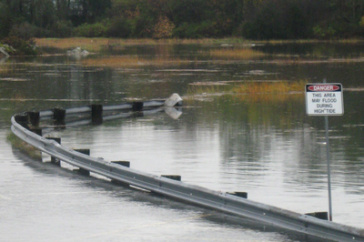UNH Climate Change Assessment to be Released at Dec. 2 Coastal Climate Summit

Photo of inundated road by Roger Stephenson courtesy of Piscataqua Region Estuaries Partnership's "2011 King Tide Photo Contest."
DURHAM, N.H. -- A comprehensive report on how the climate of New Hampshire's Piscataqua/Great Bay region has changed over the past century and how it will be affected by future human activities is set for release Friday, Dec. 2, 2011, in conjunction with the 2011 New Hampshire Coastal Climate Summit: Collaborating for Solutions.
The summit, presented by the Great Bay National Estuarine Research Reserve (GBNERR), will be held at the Hugh Gregg Coastal Conservation Center and the Great Bay Discovery Center in Greenland, N.H. It will highlight local climate research and share local climate preparedness efforts and tools aimed at helping communities move forward effectively and efficiently in the face of a changing climate.
The summit's keynote speaker and lead author of the new report, "Climate Change in the Piscataqua/Great Bay Region: Past, Present, and Future," is University of New Hampshire research associate professor Cameron Wake of the Institute for the Study of Earth, Oceans, and Space. Wake also serves as director for Carbon Solutions New England (CSNE), which published the report. CSNE is a UNH-based public-private partnership that promotes collective action to achieve a low carbon society.
"Earth's climate has always changed and it always will," notes Wake. "However, what is different today, and what an overwhelming body of scientific evidence now indicates, is that human activities, including the burning of fossil fuel for energy, clearing of forested lands for agriculture, and raising livestock, are a significant and growing force driving change in the Earth's climate system."
The take-home message of the report, and the primary focus of the summit, is understanding that the region's climate has already changed and that efforts must be taken now to both limit the extent of future change and prepare for the inevitable changes that have and will occur, including rising sea levels that will cause a significant increase in the extent and frequency of large floods inundating coastal areas.
Notes Steve Miller, the coastal training program coordinator for GBNERR and organizer of the summit, "Using regional scientific data on which we can plan local adaptation efforts, the CSNE report provides key decision-relevant information to individual, municipal, regional, and state decision makers."
According to the report, which is based on detailed analysis of data collected at four meteorological stations in and around the Piscataqua/Great Bay region over the last century, the clearest evidence that the region's climate is already changing is the frequency and magnitude of big precipitation events, both rain and snow, that result in the loss of electricity for many days at a time, and unprecedented flooding.
"We've seen four to five of these 100-year storm events in the last decade," Wake says. And, he adds, because this trend will continue, communities will be required to adapt by learning how to raise resiliency and reduce vulnerability so that, for example, roads don't get washed out and power doesn't go down every time one of these events occurs.
To account for the unknowns regarding future fossil fuel consumption, the report uses both high- and low-emissions scenarios to project potential climate changes for the region. By the end of the century under the high-emissions scenario, the number of hot days will increase to more than 60 per year; extreme precipitation events will double, and sea level will rise between 2.5 to 6.3 feet. Changes will be substantially lower under the low-emissions scenario.
"Our future climate is literally in our hands and the climate future of our children and grandchildren will depend fundamentally on decisions we make today regarding how we produce and use energy," Wake says. "We're in a new climate regime and we've got to start preparing for it, we got to start investing in our communities by developing local climate change adaptation plans."
To view the report, "Climate Change in the Piscataqua/Great Bay Region: Past, Present, and Future," visit http://carbonsolutionsne.org.
The University of New Hampshire, founded in 1866, is a world-class public research university with the feel of a New England liberal arts college. A land, sea, and space-grant university, UNH is the state's flagship public institution, enrolling 12,200 undergraduate and 2,300 graduate students.
-30-
Photographs to download:
http://www.eos.unh.edu/newsimage/climate_summit2_lg.jpg
Caption: Photo of Portsmouth lobster shack by Tim Hayes courtesy of Piscataqua Region Estuaries Partnership's "2011 King Tide Photo Contest."
http://www.eos.unh.edu/newsimage/climate_summit1_lg.jpg
Caption: Photo of inundated road by Roger Stephenson courtesy of Piscataqua Region Estuaries Partnership's "2011 King Tide Photo Contest."
Reporters and editors: Cameron Wake is available for comment at 603-862-2329 or mailto:cameron.wake@unh.edu"
Latest News
-
July 2, 2024
-
June 18, 2024
-
June 18, 2024
-
May 17, 2024
-
May 14, 2024

















































